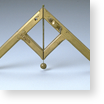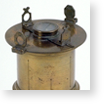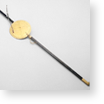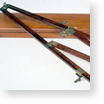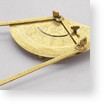In this room, numerous instruments linked to the science of warfare and military architecture are displayed. In the Renaissance, the spread of firearms had transformed battlefields into the theatre of geometric studies. Powerful mortars had compelled modifying the geometry of fortresses. Moreover, suitable knowledge of the ratio between the weight and range of cannonballs was now required, calling for the greatest precision in measurement and computation. Men of arms were thus obliged to acquire the basic mathematical principles needed for the perfect management of military operations. The display cases at the centre of the room contain instruments designed by the military engineer Baldassarre Lanci, at the service of Cosimo I de' Medici from 1557. In the last display cases are the instruments bought in Germany by Prince Mattias while fighting in the Thirty Years' War as commander of the Medicean army.
The Instruments of the Artilleryman
With the spread of firearms, the "bombardier" became a military technician highly specialized in the deployment of ordnance. To set cannon fire precisely, ...
(15 objects)
The Instruments of the Cartographer
A crucially important figure in sieges and on battlefields was the cartographer, who drew up maps of fortresses and territories. Starting from the early ...
(14 objects)
Mattias de’ Medici’s Collection
The instruments displayed here were purchased by Prince Mattias (1613-1667) while in Germany at the command of the Medicean Army during the Thirty Years' ...
(22 objects)
Measurement, Drawing and Calculation
The instruments of the commander educated in the mathematical sciences were often kept in cases and boxes. Magnetic compasses, quadrants, squares, rulers, ...
(43 objects)
Condottieri and Military Engineers
Condottieri and military engineers often invented original measuring instruments for the princes' collections. Among them are refined surveying compasses, ...










